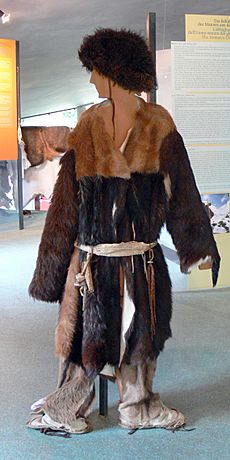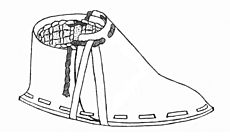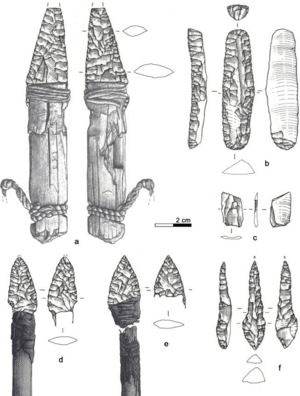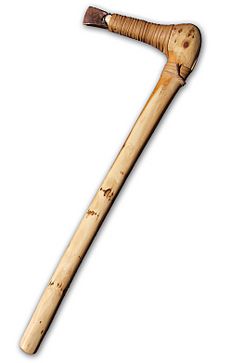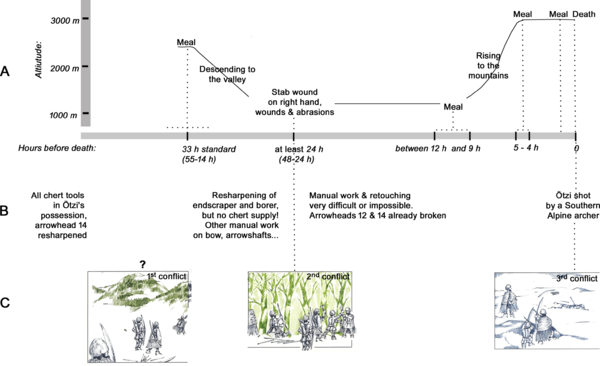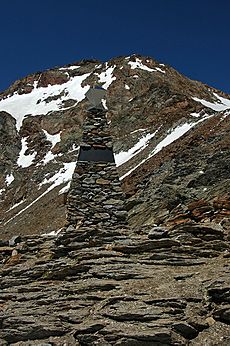Ötzi facts for kids
Quick facts for kids
Ötzi
|
|
|---|---|
| Pronunciation | German pronunciation: [ˈœtsi] |
| Born | c. 3275 BC |
| Died | c. 3230 BC (aged about 45) Ötztal Alps, near Tisenjoch on the border between Austria and Italy
|
| Other names | Ötzi the Iceman Similaun Man (Italian: Mummia del Similaun) Man from Tisenjoch Man from Hauslabjoch Frozen Man Frozen Fritz Tyrolean Iceman |
| Known for | Oldest natural mummy of a Chalcolithic (Copper Age) European man |
| Height | 1.6 m (5 ft 3 in) |
Ötzi, also called the Iceman, is the natural mummy of a man who lived between 3350 and 3105 BC. Ötzi was discovered in September 1991 in the Ötztal Alps (hence the nickname "Ötzi") at the border between Austria and Italy. He is Europe's oldest known natural human mummy, offering an unprecedented view of Chalcolithic (Copper Age) Europeans.
Researchers believe Ötzi was murdered. The nature of his life and the circumstances of his death are the subject of much investigation and speculation. His remains and personal belongings are on exhibit at the South Tyrol Museum of Archaeology in Bolzano, South Tyrol, Italy.
Contents
Discovery
Ötzi was found on 19 September 1991 by two German tourists, at an elevation of 3,210 m (10,530 ft) on the east ridge of the Fineilspitze in the Ötztal Alps on the Austrian–Italian border, near Similaun mountain and the Tisenjoch pass. When the tourists, Helmut and Erika Simon, first saw the body, they both believed that they had happened upon a recently deceased mountaineer. Within a short time, eight groups visited the site, among whom were mountaineers Hans Kammerlander and Reinhold Messner.
The body was extracted on 22 September and salvaged the following day. It was transported to the office of the medical examiner in Innsbruck, together with other objects found nearby. On 24 September, the find was examined there by archaeologist Konrad Spindler of the University of Innsbruck. He dated the find to be "at least four thousand years old" on the basis of the typology of an axe among the retrieved objects. Tissue samples from the corpse and other accompanying materials were later analyzed at several scientific institutions and their results unequivocally concluded that the remains belonged to someone who had lived between 3359 and 3105 BCE, or some 5,000 years ago. More specific estimates stated that there was a 66% chance he died between 3239 and 3105 BC, a 33% chance he died between 3359 and 3294 BC, and a 1% chance he died between 3277 and 3268 BC.
Border dispute
At the Treaty of Saint-Germain-en-Laye of 1919, the border between North and South Tyrol was defined as the watershed of the rivers Inn and Etsch. Near Tisenjoch, the glacier (which has since retreated) complicated establishing the watershed and the border was drawn too far north. Although Ötzi's find site drains to the Austrian side, surveys in October 1991 showed that the body had been located 92.56 m (101.22 yd) inside Italian territory as delineated in 1919. The province of South Tyrol claimed property rights but agreed to let Innsbruck University finish its scientific examinations. Since 1998, it has been on display at the South Tyrol Museum of Archaeology in Bolzano, the capital of South Tyrol.
Scientific analyses
The corpse has been extensively examined, measured, X-rayed, and dated. Tissues and intestinal contents have been examined microscopically, as have the items found with the body. In August 2004, frozen bodies of three Austro-Hungarian soldiers killed during the Battle of San Matteo (1918) were found on the mountain Punta San Matteo in Trentino. One body was sent to a museum in the hope that research on how the environment affected its preservation would help unravel Ötzi's past.
Body
By current estimates, at the time of his death, Ötzi was 160 cm (5 ft 3 in) tall, weighed about 50 kg (110 lb), and was about 45 years of age. When his body was found, it weighed 13.750 kg (30 lb 5.0 oz). Analysis of pollen, dust grains and the isotopic composition of his tooth enamel indicates that he spent his childhood near the present South Tyrol village of Feldthurns, north of Bolzano, but later went to live in valleys about 50 kilometres (31 mi) farther north.
High levels of both copper particles and arsenic were found in Ötzi's hair. This, along with Ötzi's copper axe blade, which is 99.7% pure copper, has led scientists to speculate that Ötzi was involved in copper smelting.
By examining the proportions of Ötzi's tibia, femur, and pelvis, it was postulated that Ötzi's lifestyle included long walks over hilly terrain. This degree of mobility is not characteristic of other Copper Age Europeans. This may indicate that Ötzi was a high-altitude shepherd.
Using modern 3D scanning technology, a facial reconstruction has been created for the South Tyrol Museum of Archaeology in Bolzano, Italy. It shows Ötzi looking old for his 45 years, with deep-set brown eyes, a beard, a furrowed face, and sunken cheeks. He is depicted as looking tired and ungroomed.
Health
Ötzi apparently had Trichuris trichiura (whipworm), an intestinal parasite. During CT scans, it was observed that three or four of his right ribs had been cracked when he had been lying face down after death, or where the ice had crushed his body. One of his fingernails (of the two found) shows three Beau's lines indicating he was sick three times in the six months before he died. The last incident, two months before he died, lasted about two weeks. It was also found that his epidermis, the outer skin layer, was missing, a natural process from his mummification in ice. Ötzi's teeth showed considerable internal deterioration from cavities. These oral pathologies may have been brought about by his grain-heavy, high carbohydrate diet. DNA analysis in February 2012 revealed that Ötzi was lactose intolerant, supporting the theory that lactose intolerance was still common at that time, despite the increasing spread of agriculture and dairying.
Skeletal details and tattooing
Ötzi had a total of 61 tattoos, consisting of 19 groups of black lines ranging from 1 to 3 mm in thickness and 7 to 40 mm long. These include groups of parallel lines running along the longitudinal axis of his body and to both sides of the lumbar spine, as well as a cruciform mark behind the right knee and on the right ankle, and parallel lines around the left wrist. The greatest concentration of markings is found on his legs, which together exhibit 12 groups of lines. A microscopic examination of samples collected from these tattoos revealed that they were created from pigment manufactured out of fireplace ash or soot. This pigment was then rubbed into small linear incisions or punctures. It has been suggested that Ötzi has been repeatedly tattooed in the same locations, since the majority of them are quite dark.
Radiological examination of Ötzi's bones showed "age-conditioned or strain-induced degeneration" corresponding to many tattooed areas, including osteochondrosis and slight spondylosis in the lumbar spine and wear-and-tear degeneration in the knee and especially in the ankle joints. It has been speculated that these tattoos may have been related to pain relief treatments similar to acupressure or acupuncture. If so, this is at least 2,000 years before their previously known earliest use in China (c. 1000 BC). It has been shown that 9 out of the 19 groups of his tattoos are located next to, or directly on acupunctural areas that are used today. The majority of the other tattoos are on meridians, other acupunctural areas of the body, or over arthritic joints. For example, the tattoos on his upper chest are placed on acupunctural locations that are thought to help with abdominal pain. Since it is presumed Ötzi had whipworm, which would cause said intestinal pain, such tattoos could have helped him feel some relief, which supports the theory that they were used for therapeutic purposes.
At one point, it was thought that Ötzi was the oldest tattooed human mummy yet discovered. In 2018, however, tattoos were discovered on nearly contemporaneous Egyptian mummies.
Many of Ötzi's tattoos originally went unnoticed since they are difficult to see with the naked eye. In 2015, researchers photographed the body using noninvasive multispectral techniques to capture images on different light wavelengths that are imperceptible by humans, revealing the remainder of his tattoos.
Clothes and shoes
Ötzi wore a cloak made of woven grass and a coat, a belt, a pair of leggings, a loincloth and shoes, all made of leather of different skins. He also wore a bearskin cap with a leather chin strap. The shoes were waterproof and wide, seemingly designed for walking across the snow; they were constructed using bearskin for the soles, deer hide for the top panels, and a netting made of tree bark. Soft grass went around the foot and in the shoe and functioned like modern socks. The coat, belt, leggings and loincloth were constructed of vertical strips of leather sewn together with sinew. His belt had a pouch sewn to it that contained a cache of useful items: a scraper, drill, flint flake, bone awl and a dried fungus (see 'Tools and equipment' below).
The shoes have since been reproduced by a Czech academic, who said that "because the shoes are actually quite complex, I'm convinced that even 5,300 years ago, people had the equivalent of a cobbler who made shoes for other people". The reproductions were found to constitute such excellent footwear that it was reported that a Czech company offered to purchase the rights to sell them. However, a more recent hypothesis by British archaeologist Jacqui Wood says that Ötzi's shoes were actually the upper part of snowshoes. According to this theory, the item currently interpreted as part of a backpack is actually the wood frame and netting of one snowshoe and animal hide to cover the face.
The leather loincloth and hide coat were made from sheepskin. Genetic analysis showed that the sheep species was nearer to modern domestic European sheep than to wild sheep; the items were made from the skins of at least four animals. Part of the coat was made from domesticated goat belonging to a mitochondrial haplogroup (a common female ancestor) that inhabits central Europe today. The coat was made from several animals from two different species and was stitched together using hides. The leggings were made from domesticated goat leather. A similar set of 5,000-year-old leggings discovered in Schnidejoch, Switzerland were made from goat leather as well.
Shoelaces were made from the European genetic population of cattle. The quiver was made from wild roe deer, the fur hat was made from a genetic lineage of brown bear which lives in the region today. Writing in the journal Scientific Reports, researchers from Ireland and Italy reported their analysis of his clothing's mitochondrial DNA, which was extracted from nine fragments from six of his garments, including his loin cloth and fur cap.
Tools and equipment
Other items found with the Iceman were a copper axe with a yew handle, a chert-bladed knife with an ash handle and a quiver of 14 arrows with viburnum and dogwood shafts. Two of the arrows, which were broken, were tipped with flint and had fletching (stabilizing fins), while the other 12 were unfinished and untipped. The arrows were found in a quiver with what is presumed to be a bow string, an unidentified tool, and an antler tool which might have been used for sharpening arrow points. There was also an unfinished yew longbow that was 1.82 m (72 in) long.
In addition, among Ötzi's possessions were berries, two birch bark baskets, and two species of polypore mushrooms with leather strings through them. One of these, the birch fungus, is known to have anthelmintic properties, and was probably used for medicinal purposes. The other was a type of tinder fungus, included with part of what appeared to be a complex firelighting kit. The kit featured pieces of over a dozen different plants, in addition to flint and pyrite for creating sparks.
Ötzi's copper axe was of particular interest. His axe's haft is 60 cm (24 in) long and made from carefully worked yew with a right-angled crook at the shoulder, leading to the blade. The 9.5 cm (3.7 in) long axe head is made of almost pure copper, produced by a combination of casting, cold forging, polishing, and sharpening. Despite the fact that copper ore sources in the Alpines are known to have been exploited at the time, a study indicated that the copper in the axe came from southern Tuscany. It was let into the forked end of the crook and fixed there using birch-tar and tight leather lashing. The blade part of the head extends out of the lashing and shows clear signs of having been used to chop and cut. At the time, such an axe would have been a valuable possession, important both as a tool and as a status symbol for the bearer.
Blood
In May 2012, scientists announced the discovery that Ötzi still had intact blood cells. These are the oldest complete human blood cells ever identified. In most bodies this old, the blood cells are either shrunken or mere remnants, but Ötzi's have the same dimensions as living red blood cells and resembled a modern-day sample.
Cause of death
The cause of death remained uncertain until 10 years after the discovery of the body. It was initially believed that Ötzi died from exposure during a winter storm. Later it was speculated that Ötzi might have been a victim of a ritual sacrifice, perhaps for being a chieftain. This explanation was inspired by theories previously advanced for the first millennium BC bodies recovered from peat bogs such as the Tollund Man and the Lindow Man.
Legal dispute
Italian law entitled the Simons to a finders' fee from the South Tyrolean provincial government of 25% of the value of Ötzi. In 1994 the authorities offered a "symbolic" reward of Lire 10 million (€5,200), which the Simons declined. In 2003, the Simons filed a lawsuit which asked a court in Bolzano to recognize their role in Ötzi's discovery and declare them his "official discoverers". The court decided in the Simons' favor in November 2003, and at the end of December that year the Simons announced that they were seeking US$300,000 as their fee. The provincial government decided to appeal.
In addition, two people came forward to claim that they were part of the same mountaineering party that came across Ötzi and discovered the body first:
- Magdalena Mohar Jarc, a retired Slovenian climber, who alleged that she discovered the corpse first after falling into a crevice, and shortly after returning to a mountain hut, asked Helmut Simon to take photographs of Ötzi. She cited Reinhold Messner, who was also present in the mountain hut, as the witness to this.
- Sandra Nemeth, from Switzerland, who contended that she found the corpse before Helmut and Erika Simon.
In 2005 the rival claims were heard by a Bolzano court. The legal case angered Mrs. Simon, who alleged that neither woman was present on the mountain that day. In 2005, Mrs. Simon's lawyer said: "Mrs. Simon is very upset by all this and by the fact that these two new claimants have decided to appear 14 years after Ötzi was found." In 2008, however, Jarc stated for a Slovene newspaper that she wrote twice to the Bolzano court in regard to her claim but received no reply whatsoever.
In 2004, Helmut Simon died. Two years later, in June 2006, an appeals court affirmed that the Simons had indeed discovered the Iceman and were therefore entitled to a finder's fee. It also ruled that the provincial government had to pay the Simons' legal costs. After this ruling, Mrs. Erika Simon reduced her claim to €150,000. The provincial government's response was that the expenses it had incurred to establish a museum and the costs of preserving the Iceman should be considered in determining the finder's fee. It insisted it would pay no more than €50,000. In September 2006, the authorities appealed the case to Italy's highest court, the Court of Cassation.
On 29 September 2008 it was announced that the provincial government and Mrs. Simon had reached a settlement of the dispute, under which she would receive €150,000 in recognition of Ötzi's discovery by her and her late husband and the tourist income that it attracts.
See also
 In Spanish: Ötzi para niños
In Spanish: Ötzi para niños
- Big Mama stela – inscription possibly associated with Ötzi's culture
- Iceman – a 2017 fictional film about the life of Ötzi
- List of unsolved murders
- Similar archaeological finds:
- Children of Llullaillaco and Mummy Juanita – high-altitude Incan mummies
- Gebelein predynastic mummies – roughly contemporaneous Egyptian mummies
- Saltmen – well-preserved Iranian mummies
- Tarim Basin Mummies – well-preserved Central Asian mummies



